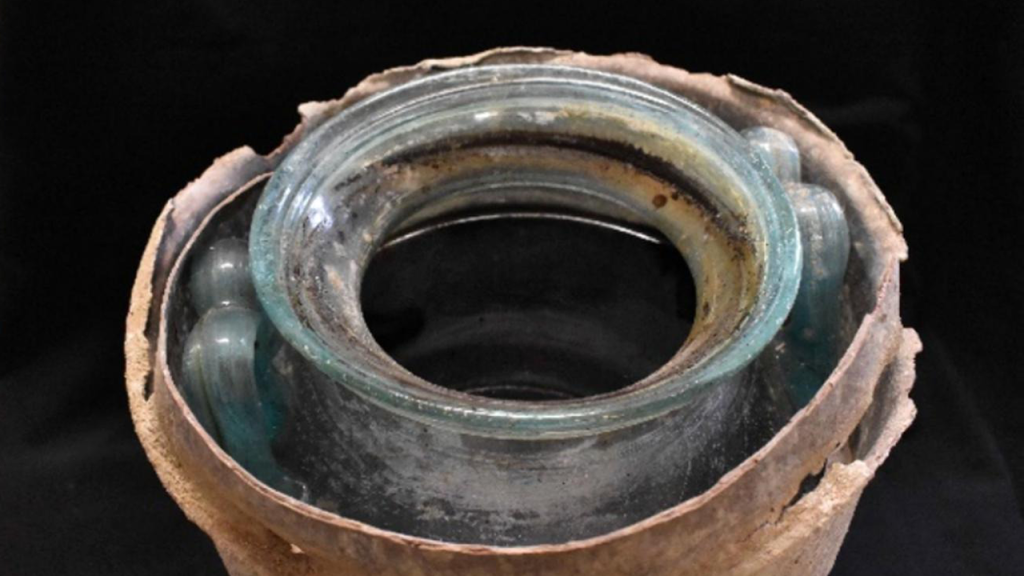The oldest bottle of wine in the world was recently discovered in an ancient Roman burial site in southern Spain, where it had been untouched for around 2,000 years. The wine was found in a glass funeral urn inside a mausoleum in the Andalusian town of Carmona by a family doing renovations on their home in 2019. Researchers confirmed that the liquid inside the urn had a reddish hue, indicating that it was indeed wine. The tomb’s conservation conditions were described as “extraordinary,” as it had been well-sealed for two millennia, allowing the wine to remain in a remarkably natural state. This discovery surpasses the previous record held by the Speyer wine bottle, dating back to the fourth century AD and currently preserved in a museum in Germany.
The team of researchers, including the City of Carmona’s municipal archaeologist and the Department of Organic Chemistry at the University of Cordoba, conducted a series of tests to confirm that the liquid in the urn was wine. Their findings were published in the Journal of Archaeological Science, detailing the remarkable preservation of the wine in the tomb. The discovery of such an old and well-preserved bottle of wine has garnered significant attention and adds to the historical significance of the ancient Roman burial site in Spain. The find sheds light on the burial practices and customs of the ancient Romans, providing valuable insights into their culture and daily life.
The discovery of the world’s oldest bottle of wine in an ancient Roman burial site has captured the interest of researchers, archaeologists, and wine enthusiasts alike. The fact that the wine remained relatively intact after 2,000 years is a testament to the exceptional preservation conditions of the tomb. The find serves as a valuable source of information about ancient winemaking techniques, the significance of wine in Roman society, and the storage practices of the time. This groundbreaking discovery provides a unique opportunity to study the chemical composition of ancient wines and gain insight into ancient Roman culture and traditions.
The ancient Roman burial site in Carmona, Spain, where the oldest bottle of wine was discovered, offers a glimpse into the past and the practices of the ancient Romans. The well-sealed tomb and the liquid preservation conditions allowed the wine to survive for centuries, providing researchers with a rare opportunity to study ancient winemaking techniques and the history of wine production. The discovery highlights the importance of preservation efforts in archaeological sites and the potential for further discoveries that could shed light on ancient cultures and societies. The findings of the study published in the Journal of Archaeological Science contribute to our understanding of ancient Roman practices and traditions.
The discovery of the world’s oldest bottle of wine in an ancient Roman burial site in Carmona, Spain, adds to the historical significance of the region and the legacy of the ancient Romans. The exceptional preservation conditions of the tomb allowed the wine to remain relatively intact for millennia, providing researchers with a unique opportunity to study ancient winemaking techniques and the cultural importance of wine in Roman society. The findings of the study published in the Journal of Archaeological Science offer valuable insights into the practices and customs of the ancient Romans, shedding light on their daily lives and burial rituals. This groundbreaking discovery contributes to our understanding of ancient civilizations and the role of wine in history.
The discovery of the world’s oldest bottle of wine in an ancient Roman burial site in Carmona, Spain, showcases the remarkable preservation of the tomb and the liquid inside the funeral urn. The reddish hue of the liquid, confirmed to be wine by researchers, highlights the cultural significance of wine in ancient Roman society. The conservation conditions of the tomb, kept well-sealed for 2,000 years, allowed the wine to maintain its natural state and surpass the previous record held by the Speyer wine bottle. The study published in the Journal of Archaeological Science underscores the importance of archaeological research in uncovering the rich history and traditions of ancient civilizations. This discovery offers a fascinating glimpse into the past and provides valuable insights into the practices and customs of the ancient Romans.


